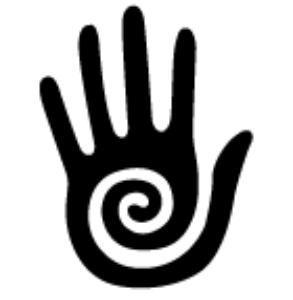TT Journal, ISSUE 7, September 2024
by Rosalyn Driscoll
Twenty artists set out to explore together the nature of water and rivers. They ended up also reflecting on the perennial metaphor of time as river. The artists are members of Think About Water, a collective of artists and activists who interpret, celebrate and protect water. They wanted to make something together but also to honor each artist’s distinctive vision. They chose the format of a game played by the Surrealists called exquisite corpse: one artist drew a head, then folded the paper so their drawing could not be seen, and handed it to another artist; that artist drew the next part of the body, folded the paper, and so on through several artists and foldings. The paper was then unfolded and the whole, surreal figure appeared.
In that spirit, the Think About Water artists created an exquisite corpse—not a human body, but the body of a river. Each artist made a section of river in their own studio in their own medium, style, vision and time, without seeing each other’s work. The artworks were then hung together in an art gallery. The assembled sequence of images snaked across the walls, suggesting a river of multiple forms and meanings.
The Exquisite River project also reveals several aspects of time. Each artist’s process of image-making took time. Each artist drew from their individual and cultural histories to create a unique image and tell a personal story. The artworks embody the depths of time and experience each artist has woven into them. In many of these artworks, time is integral to their reference to the disruptions and degradation humans have wrought on the Earth. We are now experiencing different kinds of time in our collective awareness. Gradual changes over the centuries are now accelerating very fast. Changes are visible within our lifetimes and even within seasons. Time in the urgent need to slow climate change as quickly as possible. Time in the projections by scientists of climate effects into the near and far future. Time in the time it takes to regenerate a natural domain devastated by human abuse. We are being forced to grasp different kinds of time, accustomed as we have been to seeing, thinking and behaving in short-term ways, oblivious to the longer-term impacts of our actions. We are living in a time that makes us simultaneously aware of geological time, evolutionary time, biological time, oceanic time, the timing of seasons, the timing of a monsoon, and the impacts of humans in our time on Earth. Using the metaphor of exquisite corpse calls into question the finite life and even the mortality of our beloved rivers. Will we help them regenerate and renew or will they diminish and die, as some already have?
The first exhibition of Exquisite River took place at Ely Center for Contemporary Art in New Haven, Connecticut, USA, April 14 – June 2, 2024. The project is available to travel to other venues.In the gallery, the artworks were hung separately to create a flow. In the digital version they were linked into one long river. The following selection from among the twenty artworks provides different visions of rivers and of time.

aluminum foil, 25” x 34” x 2”
Springs are the source of most rivers. These liminal, miraculous places, where groundwater emerges from the underworld onto the surface, have been sacred to people throughout the world and time. Many are now threatened by groundwater extraction and neglect. Springs are the visible manifestation of groundwater moving under the surface, sometimes great distances. Some water takes hundreds of years to travel underground from a glacier or snowy mountain, through many rock strata, to finally emerge as a spring hundreds of miles away. The longer water moves through rock, the more minerals and chemicals it absorbs, sometimes becoming enriched, sometimes toxic.
Groundwater is like the underworld of our psyches, the unconscious dimensions of our lives. In dreams and in the imagination, time does not follow the clock: it proves adaptive and inventive. Exquisite River exists in dreamtime. Each artist’s work emerges from his or her imaginal life, transforming ordinary matter into a magical, meaningful combination of forms, colors, dimensions and time.
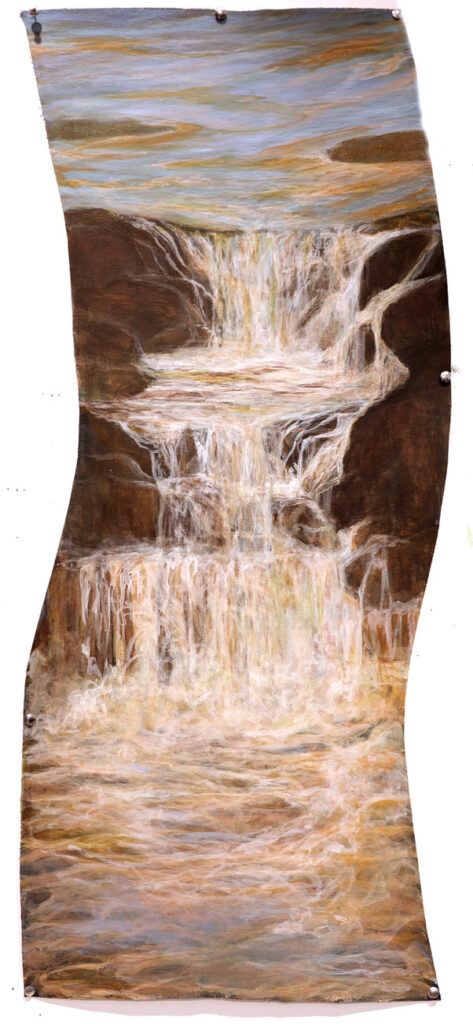
2024, Acrylic painting, 15” x 36”
Permafrost is melting in parts of the Alaska Arctic in the Brooks Mountain Range. As it melts, iron, occurring naturally in this very deep soil, dissolves into the river water. Microbes begin eating lifeforms that rotted in this soil millennia ago, releasing methane, acid, viruses, and possibly anthrax. The water becomes orange and acidic. These processes of dissolution, decay and transformation occur both underground and above ground; both waters and both kinds of time are are made palpable and visible in this painting by Fredericka Foster, the founder of Think About Water.

2023, Fabric and thread, 29” x 58”
Suzuki sewed this cloth version of Katsuta River, the only river she knew intimately as she was growing up in Japan. She has fond memories of walking by the river with her family and dog. Katsuta River is actually a canal, part of a system for irrigating the rice paddies. Nowadays, no longer used for irrigation, the river is hidden by tall weeds and its source is under concrete. Suzuki integrates the fabrics of her childhood into this piece, using part of her mother’s obi as the body of the river. She added parts of her father’s pillowcase, her own yukata and her mother’s dresses. She sewed together her childhood, her family’s past and the river’s history, arriving in the present time with a celebration of river, family and culture.

Video, 8.48 minutes
Irland integrates communal effort, scientific knowledge, artistic expression and climate activism into these ice books. In her workshops, people embed native seeds in blocks of ice that have been formed into open books. These ice books are then gently launched into the current of a river. As they float downstream and melt, the native seeds (selected in consultation with local stream ecologists and botanists) are released and plant themselves along riverbanks, as happens in nature. Irland has created fusions of time and regeneration within the conceptual framework of the complex issues of climate disruption and watershed restoration.
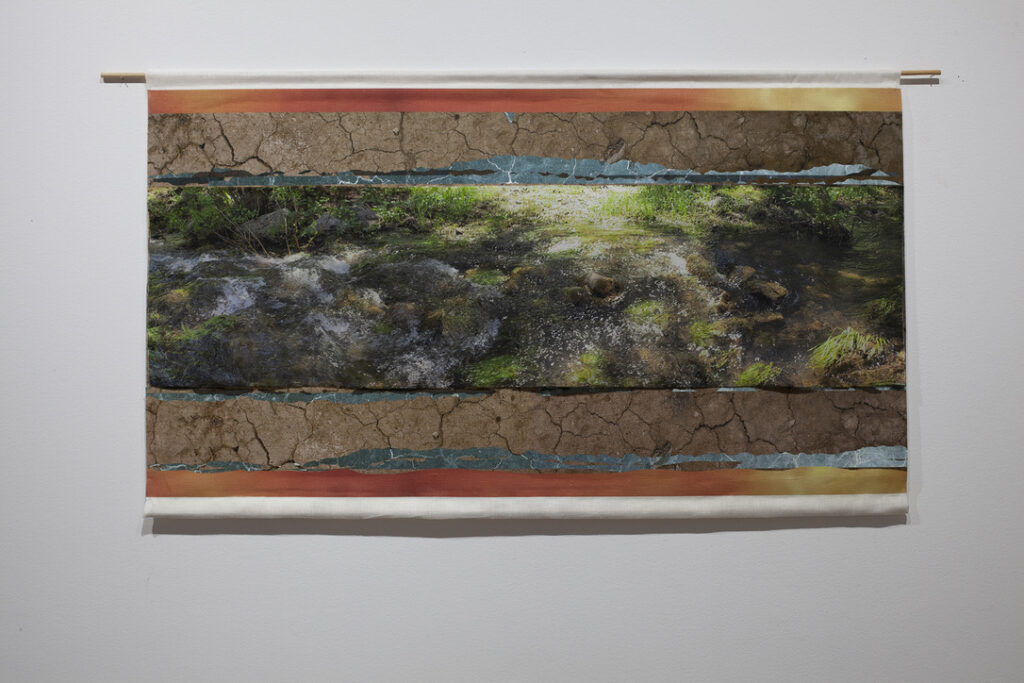
2024, Digital inks on silk and linen, 19” x 36”
Rubenstein was called to Santa Barbara River near Penasco, New Mexico, to camp beside the roaring springtime mountain river. She and her friends needed to regroup after a devastating year of fires and floods. The April 2022 Hermit’s Peak/Calf Canyon fire, the largest in New Mexico history, was a Forest Service prescribed burn gone awry. It burned 340,000 acres, homes, farms, and water infrastructure. Three months later, early and unusually intense monsoons caused massive flooding, drownings and forced the same people to leave their homes a second time.
Rubenstein feels the fragility of these times and hopes that our precious waters can survive.

2024, Mixed media painting on paper, 11.5” x 60”
This painting depicts the lower Jordan River as it enters the Dead Sea. Once a mighty river, ripe with historical and religious significance, the Jordon has been damned, diverted and polluted, and the victim of political conflict and climate change. As a result, once it reaches the Dead Sea, the “river” is just a trickle.
Incorporated into this mixed-media painting are cyanotype prints of satellite images showing the southern portion of the Jordan, which flows in an irregular line. The once verdant land around the river is now desert.

2024, Textile wall hanging, watercolor with Blackwater River water on Indian silk/text printed on Irish linen, 38” 32”
Boyle made this poem and painting after hearing a fisherman speak about the waterways of Lough Ramor and the Blackwater River in Ireland at a public environmental meeting. His observations were informed by a lifetime spent standing in the River Boyne. He spoke clearly and passionately about this magnificent river, known for its rich myth and beauty; it now suffers from pollution and loss of biodiversity. Boyle believes the fisherman speaks for the river, for water everywhere and that his words are a universal call to us all.
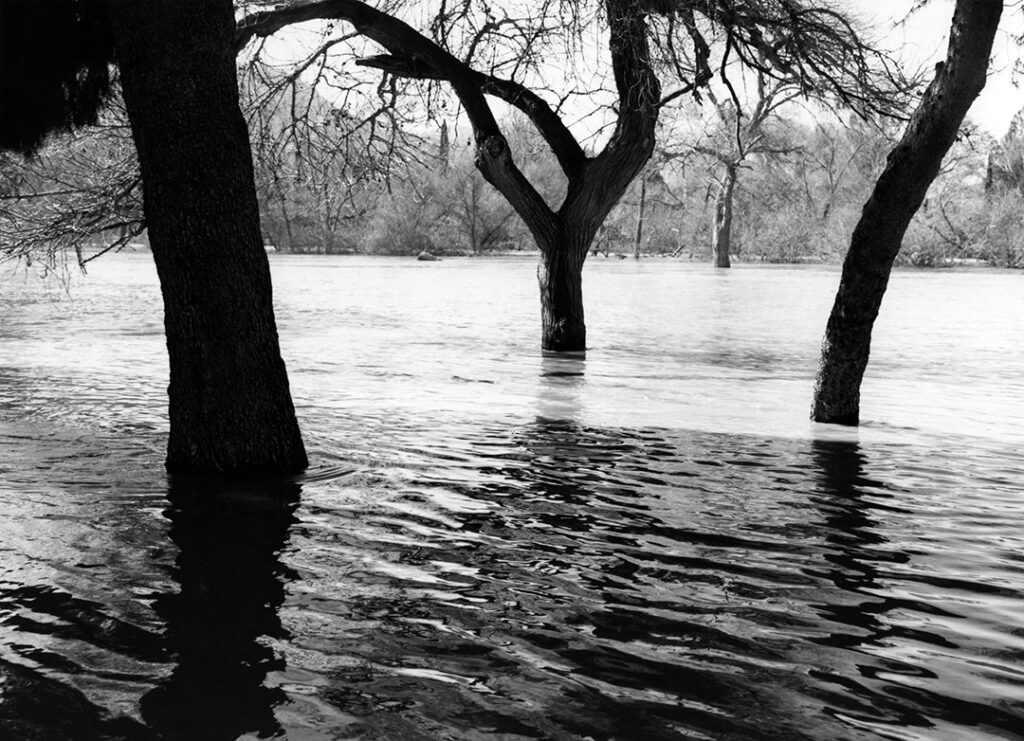
2005/2024, Archival pigment print, 19” x 24”
Khalsa’s photograph depicts trees that were flooded south of the Prado Dam, when water was intentionally released during a huge rainstorm that compromised the dam. The trees are impacted daily by natural weather events, human acts, and climate change.
Khalsa often refers to the 96-mile-long Santa Ana River in Southern California as “my river” alluding not to ownership or control but rather the intimate relationship one develops over time with a dear old friend. The Santa Ana River serves as a source of vital sustenance for her body, mind, and creative spirit as well as a source that nourishes the earth and every living cell in the community where she lives. The river has taught her the critical interdependence between humans and the natural world.
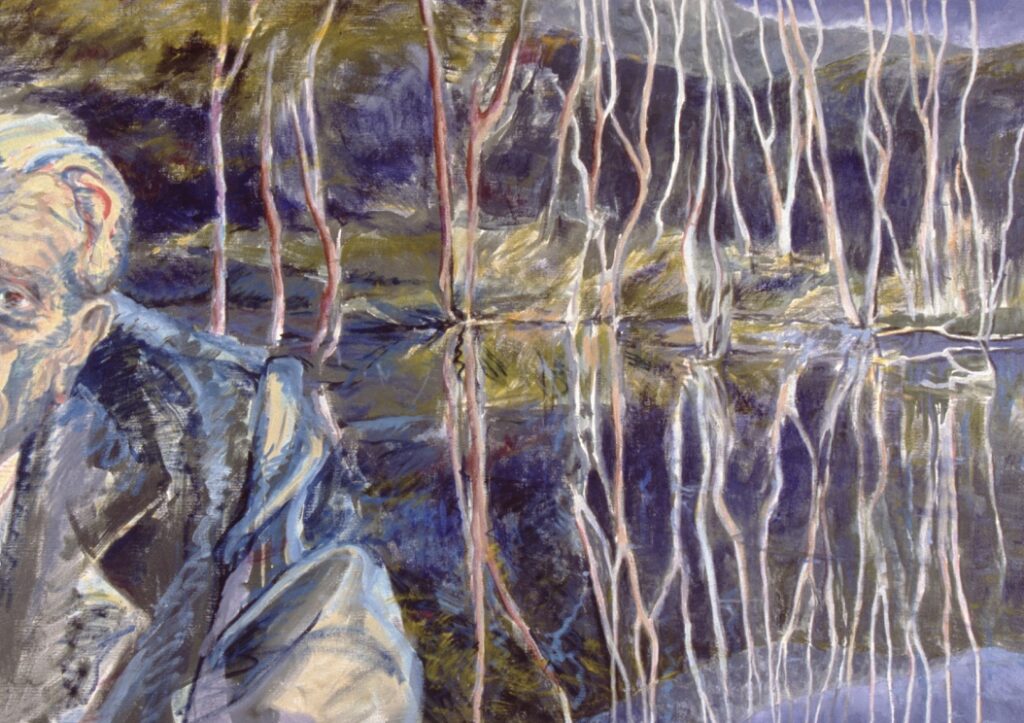
1987, Oil on linen, 40” x 72”
Rahmani writes: My father owned land near rivers when I was a child. He had an eye for a good piece of property and a knack for developing the land into solid homes for families. It was an education for me to watch how he thought about land by water, but the price of that education was to watch the land vanish under each new home. The money he made from selling the homes paid for my early education, and when I was nineteen, it made me an artist. The memories of land by water feed heart tributaries, calling for Earth healing.

2024, Oil on vellum 24” x 36” x 8”
The möbius strip is a continuum with no beginning or end. That concept encompasses the role of water in our environment. It has no beginning or end. Rain falls from the sky, it is taken up by plants and organisms, it evaporates into water vapor, condenses to form clouds, and then precipitates back to earth, sinks into the ground, and forms streams and rivers that flow into the seas. We must actively safeguard this resource to make sure it truly continues and does not have an end.

2024, Photograph, ed. 1/6, printed on fabric, 14” x 65”
The Taroko Gorge is still carving its path through the marble in Taiwan. Rising mountains in slow-motion, the Eurasian and Philippine geologic plates (known as the “Penglai Orogeny’’) are continuously moving there, growing over millions of years from sea level to heights above 3400 meters, increasing a few millimeters annually. Originally, elementally composed of raw calcium, the earth “lithified” into limestone, which then metamorphosed into marble, gneiss, and schist inside the mountains. Heavy subtropical rainstorms throughout the year coaxed the Liwu River into being, and still feed it now, while humankind and landslides alter the path, the waterflow and debris navigating steep dramatic canyons and valleys, to ultimately join the sea.

2023, Mixed media, 2’ x 3’
Daw writes: My creation of a river delta, the ending of a river, is closely related to the slow decline and death of my husband. A river ending in a delta transitions slowly from its river identity to the sea, gradually changing along the way. Having moved sediment along its defined route for many years, now as the flow slows, it drops off grains of soil and sludge—depositing these to build up new tendrils of meandering waterways. A slowing person gradually drops physical and mental abilities, develops a meandering mind, and the medical devices— connecting tendrils—become part of the mass of the person. Although there are still some defined river channels, it’s as though the water and the land have infiltrated one another, co-mingling life and death, the river and not the river.
The pieces in Exquisite River, like the exquisite corpse drawing, and like time itself, are made of many sensibilities, materials, methods and manifestations. They unfolded from their separate studios to reveal an implicit throughline or flow: each artist’s passion for water and for rivers. This passion runs through all the artworks and fuses the many tributaries into one exquisite river.

Rosalyn Driscoll is a visual artist who makes sculptures and installations with sensuous, elemental materials, human scale and natural forms. For a decade she made sculptures for people to touch, documented in her book, The Sensing Body in the Visual Arts (Bloomsbury, 2020). She has made installations in natural and urban landscapes, is currently working on projects that address threats to springs and groundwater, and served as curator for Exquisite River. Her work has been awarded numerous fellowships and residencies and exhibited globally.
You can read another essay by Rosalyn Driscoll in Tangible Territory journal (issue n. 1):
